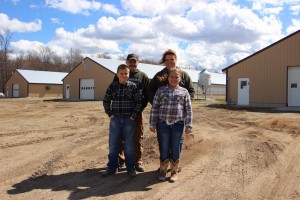
GREENWICH, Ohio — Slightly east of Greenwich, on state Route 224, a white chicken mailbox guards a long dirt lane that leads back to the largest laying hen operation in Huron County, Ohio. More than 160,000 fertilized eggs move twice a week from three large commercial chicken barns — housing up to 13,000 hens and roosters — to local hatcheries in the county that will use the eggs to supply broiler operations.
Henry and Stacey Calame purchased the farm 12 years ago. Henry had farmed the ground previously, growing mostly corn and soybeans, but both had full-time jobs elsewhere — Henry as a factory worker and Stacey working for Norwalk Schools.

Full-time farming
“We decided we wanted to farm full time,” said Stacey, but there wasn’t enough rental ground available to continue grain farming. Three years ago, the Calames decided to go into the poultry business. “We were throwing around the idea and it just made the most sense for us,” said Stacey.
It took a year to clear ground and build three large commercial laying facilities on roughly 12 acres behind their home. The Calames contract their layers and roosters through a major poultry operation in northeast Ohio. The chickens stay on the farm for 11 months and then a new group of chickens is brought in.
Easy living
While the chickens are housed at the Calame facility, they are given the best living conditions to produce quality eggs. “These chickens live a glamorous life, I think,” said Stacey. “We keep the barns at a comfortable 68 degrees all year round.”
She fears the perception of their modern poultry operation may be a bit skewed by what people can see from the road. But inside the barns, the chickens have plenty of room to roam freely from one end of the barn to the other. For biosecurity reasons, Farm and Dairy was not allowed to enter the area where the chickens are housed.
The roosters hang out on the lower level of the barn while the hens roost higher on nesting boxes. Fresh sawdust is supplied for the chickens to rest comfortably and water is always available. “You could leave the door open without worrying about them venturing out,” said Henry. “It’s just too comfortable in there.”
Day in the life

The lights come on at 5 a.m. each morning and feed is delivered to the chickens through an automated system to ensure they get the right amount, said Stacey. Henry, Stacey and Henry’s parents — who are retired — are assigned to a barn for barn checks and egg collecting. “We do a walk-through to make sure the chickens are up and eating,” said Stacey. But Henry added, “You never enter the hen house without knocking.” Just yanking open the door without warning could mean feathers flying and some very frazzled birds.
Collecting eggs
From 8-11:30 a.m., eggs are collected. Nesting boxes are placed on an angle, so that when a hen gets up from the box, the egg gently rolls to a covered conveyor belt the carries the eggs to a collecting area outside of the birds’ living space. The eggs are collected by hand and sorted into cartons. Because they are collected by hand, the Calames can make sure there are no defects in the eggs.
“We’ve been asked why we don’t just have a robot collect the eggs for us,” said Stacey. “A robot wouldn’t know the difference between the bad eggs and pack them all together.” During peak season (after about two months of receiving the chickens), the chickens will produce 10,000 eggs a day and Stacey said egg collecting can take up to 4 hours.
After the eggs have been sorted and stored in giant coolers, it’s time for a lunch break before coming out for round two of egg collecting at 4 p.m. The egg truck comes to pick up the stored eggs twice a week and transports them to area hatcheries.
No vacations
Henry still farms some grain, which is mostly used to feed their small beef operation that is located nearby on Henry’s parents’ farm. Henry and Stacey’s children, Makenna and Logan, are able to keep a couple 4-H projects in a small barn closer to their house. For biosecurity reasons, they cannot be housed near the chicken facility.
“This is a seven-day-a-week job,” said Stacey. “You have to be here, the chickens don’t stop laying eggs.” But the Calame family has no intent to stop raising chickens anytime soon. “We are considering putting up three more barns,” said Henry. “But that means more help is needed,” said Stacey.










